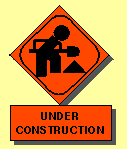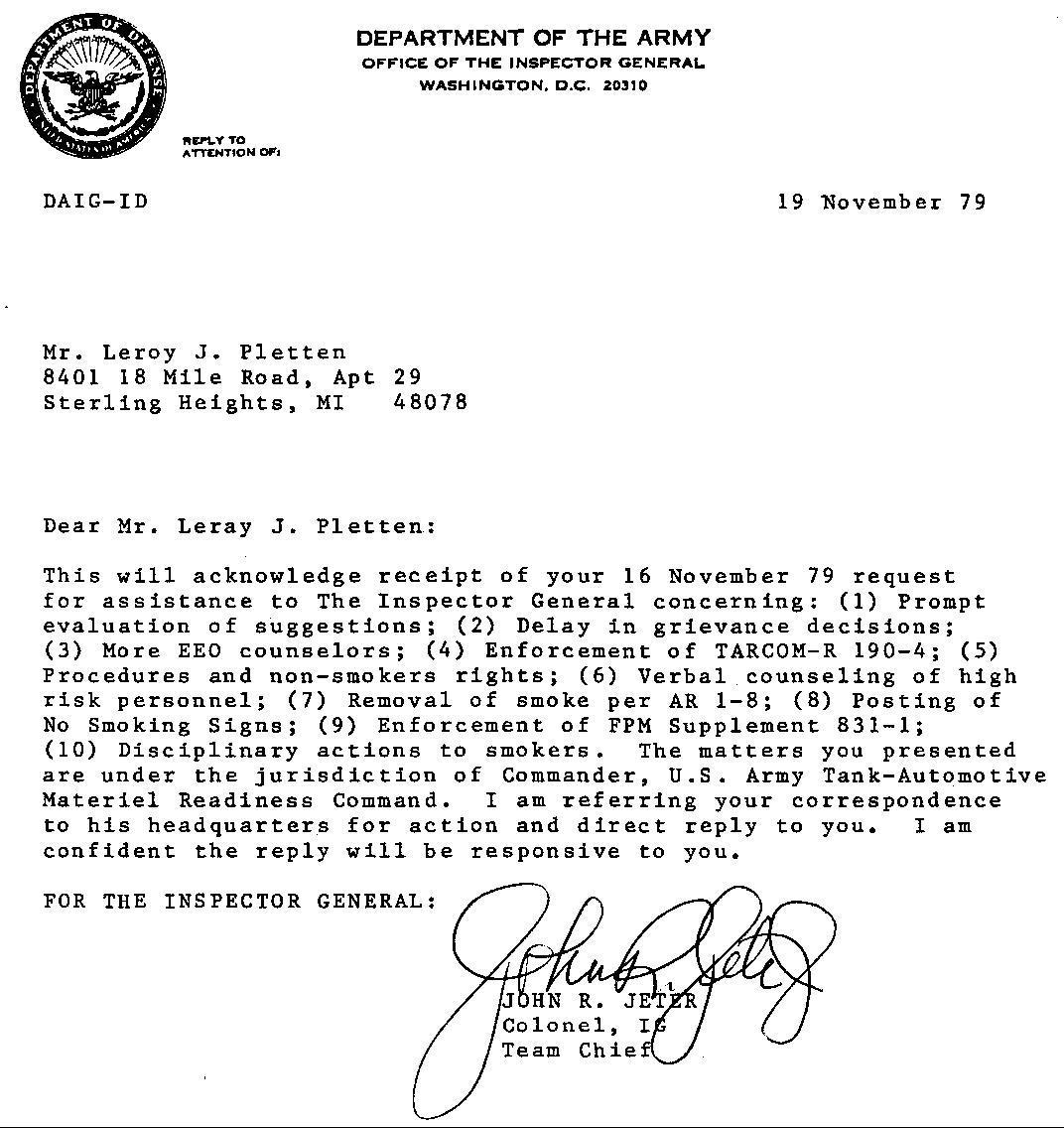
| Appeal to EEOC, 21 September 1982, in Effort to Get Review to Begin, of the TACOM Decision to Terminate, Retaliating Against Pletten's Whistleblowing.
This material parallels other Briefs in the series, e.g., 22 July 1982, 25 Aug 1982, 3 Sept 1982, 15 April 1983, 25 Nov 1983, 2 Jan 1985, and continuing into the 1990's and into 2004. There are many, as per Pletten's working full-time+ developing every evidence for seeking his reinstatement, and recording his position, for anticipated use in the EEOC forum, which TACOM was and is obstructing. More in the series will be posted as scanned. The volume is enormous, takes some time. |

| Page 1-16 of ___47____ pages. | Affiant's initials _________ |
| Page 17 of ___47____ pages. | Affiant's initials _________ |

| Page 18 of ___47____ pages. | Affiant's initials _________ |
| Page 19 of ___47____ pages. | Affiant's initials _________ |
| Page 20 of ___47____ pages. | Affiant's initials _________ |
| Page 21 of ___47____ pages. | Affiant's initials _________ |
| Page 22 of ___47____ pages. | Affiant's initials _________ |
| Page 23 of __47_____ pages. | Affiant's initials _________ |

| Page 24 of ___47____ pages. | Affiant's initials _________ |
| “Schizophrenic reactions | Speech vague, ambiguous, difficult to follow; no concern about inability to communicate; past tense common.”
|
| “Drug-induced 'model psychoses' | Speech rambling or incoherent but usually related to reality; subjects try to communicate thoughts; present tense used.” | |
| Page 25 of ____47___ pages. | Affiant's initials _________ |

| Page 26 of ___47____ pages. | Affiant's initials _________ |
“Dr. Frankl-Hochwart, after a careful study of several thousand cases, states that 'the localisation of the toxic action of nicotine is much like that of syphilis,' that is, upon the nerves and blood-vessels.” “Tobacco, like alcohol and opium, acts especially upon the nervous system (Campbell).” “Recent studies of the brain and nerves by the refined methods of the modern laboratory, show that every irritant poison produces immediate damage of the fine structures of the brain, lessening the acuteness of thought and the quickness and accuracy of nerve activity. . . . The free or prolonged use of tobacco is recognized as one of the most common causes of insanity.” At 41, “Tobacco, by incessant irritation, predisposes to mucous plaques and cancer. On this account syphilitics are forbidden to smoke.”
“General paresis is a mental disorder caused by the progressive infiltration and destruction of brain tissue by the spirochetes of syphilis. It has also been variously called general paralysis of the insane, dementia paralytica, and paresis. . . . The first symptoms usually appear about 10 to 15 years after the primary infection, although the incubation period may be as short as 2 years or as long as 40. Unless the person receives treatment, the outcome is always fatal, death usually occurring within 2 to 3 years after the initial symptoms. General paresis is associated with a wide range of behavioral and psychological symptoms. During the early phase of this disorder, the individual typically becomes careless and inattentive and makes mistakes in his work. At first he may notice his mistakes but attributes them to being overtired; later he does not even notice them. . . . Comprehension and judgment suffer, and the individual may show a tendency to evade important problems, or he may react to them with smug indifference. Accompanying these symptoms is a blunting of affect . . . He seems unable to realize the seriousness of his behavior and may become irritable or resort to ready rationalizations if his behavior is questioned. . . . As the disorder progresses . . . the individual is unmannerly, tactless, unconcerned with his appearance, and unethical [abulic] in his behavior. Memory defects, which may be noticeable in the early phases of the illness, become more obvious. . . . This memory impairment extends to remote events, and the individual tends to fill in memory losses by various fabrications.”
| Page 27 of ____47___ pages. | Affiant's initials _________ |

| Pages 28-31 of ___47____ pages. | Affiant's initials _________ |
| Page 31 of 47 pages. | Affiant's initials _________ |
| Page 32 of ___47____ pages. | Affiant's initials _________ |

| Pages 33-34 of ___47____ pages. | Affiant's initials _________ |
| Ed. Note: See also judicial rejection of employee action “equivalent to a repeal of the statute, [as] a continuing invitation to [action by] the company to forbear compliance with its provisions,” American Zinc Co. v. Graham, 132 Tenn 586, 589; 179 SW 138, 139-140 (1915). |
| Page 35 of ___47____ pages. | Affiant's initials _________ |

| Pages 36-41 of ___47____ pages. | Affiant's initials _________ |
| Page 42 of ___47____ pages. | Affiant's initials _________ |
| Page 43 of ___47____ pages. | Affiant's initials _________ |
| Page 44 of ___47____ pages. | Affiant's initials _________ |
| Page 45 of ___47____ pages. | Affiant's initials _________ |
 guidance contained in FPM Supplement 831-1, S10-la(3), is insightful. Disability retirement is not proper as a “result of vicious habits, intemperance, or willful misconduct on his or her part.” That guidance poses a bar to disability retirement for smokers/alcoholics, etc. On 16 Nov 79, I had filed a complaint to the Inspector General concerning local failure to implement this guidance. The later [involuntary disability] application [1981] directed against me reflects reprisal, as [smoker] Mr. Hoover was involved in both the disregard of the rules, and the application. It is clear that the disability retirement application was void ab initio.
guidance contained in FPM Supplement 831-1, S10-la(3), is insightful. Disability retirement is not proper as a “result of vicious habits, intemperance, or willful misconduct on his or her part.” That guidance poses a bar to disability retirement for smokers/alcoholics, etc. On 16 Nov 79, I had filed a complaint to the Inspector General concerning local failure to implement this guidance. The later [involuntary disability] application [1981] directed against me reflects reprisal, as [smoker] Mr. Hoover was involved in both the disregard of the rules, and the application. It is clear that the disability retirement application was void ab initio.
| Page 46 of ___47____ pages. | Affiant's initials _________ |

| Page 47 of ___47____ pages. | Affiant's initials _________ |